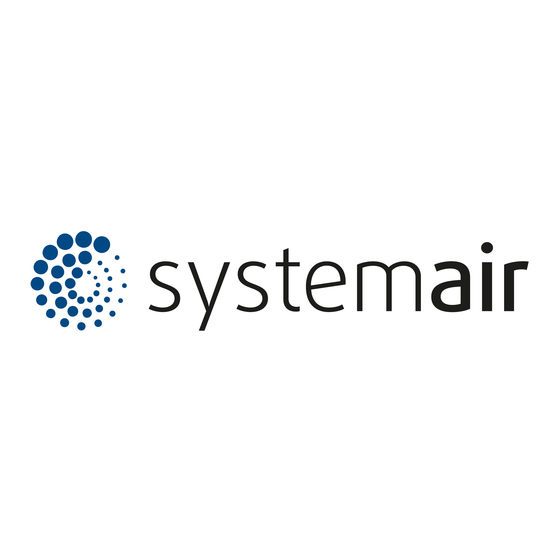Table of Contents
Advertisement
Available languages
Available languages
Quick Links
Systemair GmbH – Seehöfer Str. 45 – D-97944 Boxberg-Windischbuch
Tel.: +49 (0) 79 30 / 92 72 - 0 – Fax: +49 (0) 79 30 / 92 72 - 92
info@systemair.de
F200, F300, F400 EN 12101-3 (400˚C, 120 Min.)
DVG-H/F400
Anleitung für Transport, Montage, Inbetriebnahme und
Instandhaltung von
Anlage:
Montage vom Revisionsschalter, Anschlussschemen
Instructions for transport, installation, commissioning and
maintenance of smoke extract roof fans DVG Type
Appendix:
Mounting of service switch, wiring diagrams
– www.systemair.de
DVG-H / DVG-V
Brandgas-Ventilatoren Typ DVG
- 1 -
DVG-V/F400
Seite 2
Page 9
Advertisement
Table of Contents

Summary of Contents for SystemAir DVG-H/F200
- Page 1 Systemair GmbH – Seehöfer Str. 45 – D-97944 Boxberg-Windischbuch Tel.: +49 (0) 79 30 / 92 72 - 0 – Fax: +49 (0) 79 30 / 92 72 - 92 info@systemair.de – www.systemair.de DVG-H / DVG-V F200, F300, F400 EN 12101-3 (400˚C, 120 Min.)
-
Page 2: Table Of Contents
Inhaltsverzeichnis VERWENDUNG TECHNISCHE BESCHREIBUNG TRANSPORT UND LAGERUNG 3.1 Transport 3.2 Lagerung MONTAGEANLEITUNG 4.1 Prüfung vor der Montage 4.2 Sicherheitshinweise für Montage, Inbetriebnahme, Instandhaltung und Kontrolle 4.3 Montage des Ventilators 4.4 Installationshinweise INBETRIEBNAHME ABNAHME INSTANDHALTUNG UND KONTROLLE BETRIEBSSTÖRUNGEN GEWÄHRLEISTUNG Anlage: • Gewährleistung •... -
Page 3: Verwendung
1.0 VERWENDUNG Brandgasventilatoren werden im Brandfall für die Absaugung der Rauchgase aus Räumen und zur täglichen Entlüftung bei normalen Betriebsbedingungen verwendet. Durch die Rauchfreihaltung der Räume und Fluchtwege wird die Rettung der Personen und der Ausstattung im Brandfall erleichtert. Das Feuer wird schnell und erfolgreich gelöscht, Gebäude und Anlagen werden vor übermäßiger Temperatur geschützt, die Ausbreitung des Brandes in die Umgebung wird gehemmt. -
Page 4: Lagerung
• Vor Installation ist die örtliche Sicherheit und Stabilität mit dem Anlagenbetreiber bzw. mit den Gebäudeverantwortlich zu überprüfen; • Die Installation muss waagrecht ausgeführt werden. Es wird empfohlen einen mindestens 250 mm hohen passenden Sockel zu verwenden (wir empfehlen den Einsatz von Systemair Serienzubehör); - 4 -... -
Page 5: Installationshinweise
• Ventilatoren werden mittels 4 Schrauben an den Ecken der Grundplatte befestigt; • Während der Montage ist pfleglich mit dem Produkt umzugehen. Deformationen z.B. am Gehäuse sind zu vermeiden; • Freilaufprüfung des Laufrades; • Zugang zum Ventilator für Instandhaltung muss gewährleistet sein. Bei allen Aufstellungen sind die Abmessungen des Ventilators und eventuelle Ausdehnungen der Teile durch Temperaturänderung zu berücksichtigen (elastische Stutzen entsprechender Temperatur /... -
Page 6: Inbetriebnahme
5.0 INBETRIEBNAHME Vor der Erstinbetriebnahme ist die Betriebsanleitung sorgfältig zu lesen und folgendes zu prüfen: • Aufstellung des Gerätes (Befestigung, eventuelle Deformationen); • Dichtheit aller Verbindungen; • Montagerückstände und Fremdkörper im Ventilatorraum und im angeschlossenem Kanal; • Sicherheitseinrichtungen montiert; • Korrekte Ausführung und Anschluss der Elektroinstallation. Nach dieser Prüfung ist das Gerät kurzzeitig ein- und auszuschalten, um die Drehrichtung des Laufrades zu überprüfen. -
Page 7: Betriebsstörungen
8. Überprüfen auf eventuelle Vibrationen; 9. Überprüfung der Geräuschentwicklung, die in den Motorlagern auftreten könnten. Die Funktion und Steuerung (allpolig) der Anlage ist, wenn nicht anders gefordert, alle 3 Monate nach Wartungsbuch zu prüfen. Betrieb min. 15 Minuten jedes mal, einmal jährlich 3 Stunden empfohlen, wenn möglich. - Page 8 Gültigkeit der Gewährleistung muss der Betreiber der Anlage auch das ausgefüllte und unterschriebene Kontrollblatt vorlegen. Wir bitten Sie, die Installation sorgfältig durchführen zu lassen, denn nur damit kann ein ungestörter und sicherer Betrieb gewährleistet und zugesichert werden. - 8 -...
- Page 9 Index APPLICATION TECHNICAL DESCRIPTION TRANSPORT AND STORAGE 3.1 Transport 3.2 Storage INSTRUCTIONS FOR INSTALLATION 4.1 Inspection before installation 4.2 Safety instructions for installation, commissioning, maintenance and controlling 4.3 Installation of the fan 4.4 Instructions for installation COMMISSIONING APPROVAL MAINTENANCE AND PERIODIC CONTROL SYSTEM MALFUNCTIONS DURING OPERATION GUARANTEE Attachment:...
- Page 10 1.0 APPLICATION Smoke extract roof fans are designed for use in powered smoke and heat exhaust ventilating systems in the event of fire, and ventilating in normal conditions. Ventilated areas and emergency exits contribute to easier evacuation of people and equipment in the event of fire, and to faster and more efficient fire extinguishing;...
- Page 11 3.2 Storage Store the fans in a dry, weather and dust protected place. If this is impossible, it is important to raise the fan above the ground surface and cover it with a PE foil. 4.0 INSTRUCTIONS FOR INSTALLATION 4.1 Inspection before installation Each fan is controlled by the manufacturer before delivery.
- Page 12 At installation the dimensions of the fan and possible extension of parts by the temperature rise is to be considered (provide flexible connection of appropriate temperature/time class )! 4.4 Instructions for installation Air ducting system The suction side of the fan is provided with a connection for flange-type mounting of the air duct (6 resp.
- Page 13 Protective glasses are needed to avoid any injury of the eyes. If the direction of rotation of the impeller is wrong, change the supply connection of 2 phases. Re-start the fan and check it for proper operation (smoothly rotating impeller, current at all speeds, eventual vibrations, noise).
- Page 14 8.0 SYSTEM MALFUNCTIONS DURING OPERATION For all inspections, point 4.2. must be considered. Possible malfunctions and solutions: Check connection to the mains and thermal protection. If ok. check The fan does not operate electric motor. If a motor with separated windings is installed, check all speeds.
- Page 15 Anlage 1. Montage des Revisionsschalters / Montage der Umlenkungsbleche bei DVG-V Appendix 1. Mounting of service switch / Mounting of vertical outlets for DVG-V...
- Page 16 Anlage 2. Anschlussschemen DVG / Appendix 2. Wiring diagrams DVG Motor ohne thermischen Schutz Electric motor without thermal protection built-in NO NC NO NC Dahlander Elektrisk motor utan NO NC NO NC L1 L2 L3 NO NC termokontaktmotorskydd NO NC NO NC Двигатель...













Need help?
Do you have a question about the DVG-H/F200 and is the answer not in the manual?
Questions and answers